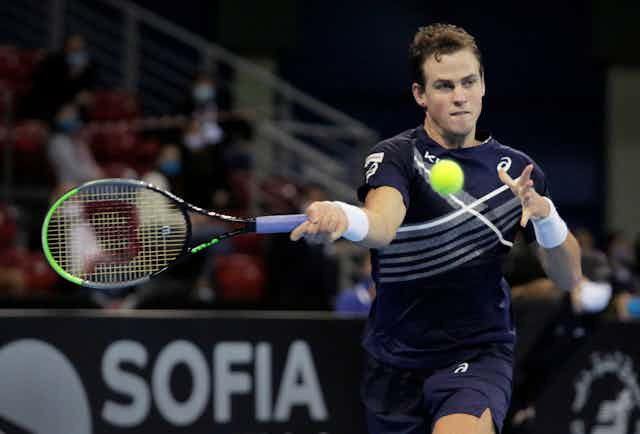In August 2020, on the eve of the U.S. Open Championship, professional tennis players Novak Djokovic and Vasek Pospisil resigned from the Association of Tennis Professionals (ATP) player council. In a letter sent to players, Djokovic and Pospisil announced the formation of the new Professional Tennis Players’ Association (PTPA).
Approximately 200 men and women tennis players have signed an expression of interest to join the association. The PTPA aims to be an independent body that will advocate on behalf of players, prioritize athlete health and safety, and increase prize money distribution and financial transparency in the sport.
Conflicts of interest
Professional organizations that govern tennis — the ATP and the Women’s Tennis Association (WTA) — claim adequate representation is provided to athletes within their current governance structures and therefore forbid tennis players to form unions. The ATP’s governance structure includes a chairperson, three player representatives and three tournament representatives. Player representatives are corporate partners such as tournament directors and media personnel, elected to the board by the ATP player council.
Corporate partners representing players is a conundrum: their board seat means they must advocate on behalf of athletes, but they may have conflicting business interests.
The current ATP player council includes four players elected in 2018 and four players selected by those already on the council without a general member vote.
Some player council members and other active players on tour have ties to tournaments, further muddying the waters. For example, Austria’s Dominic Thiem is represented by Herwig Straka, who is the tournament director of the Vienna ATP 500 event and holds a position on the ATP board.
Roger Federer is on the ATP player council and he’s another example of an active player with ties to tournaments. He is the founder of the Laver Cup, an ATP-sanctioned, exhibition-style tournament held annually. The Laver Cup is managed by Trident8, an affiliate of Federer’s TEAM8 Global Management firm.
Through the Laver Cup, Federer is also connected to the organizers of the Australian Open Championship. Craig Tiley (CEO, Tennis Australia) is on Trident8’s board of directors, along with Gordon Smith (ex-CEO, U.S. Tennis Association) and Anthony Godsick (Federer’s agent and business partner).
Following the money
The primary source of revenue for most tennis players is prize money. Revenue sharing in tennis refers to prize money earned by players as a percentage of the total revenue of the tournament. New York Times reporter Christopher Clarey highlighted the disparity in revenue sharing using the U.S. Open financials. In 2018, the U.S. Tennis Association reported approximately US$380 million in revenue and paid US$53 million in prize money, which equates to 13.94 per cent. Men and women competing at the tournament received just under seven per cent each.
Other Grand Slams follow a similar pattern of disparity between revenues earned and prize money awarded to players.
In contrast, revenue sharing between players and the league is significantly higher in other sports: 48 per cent in Major League Baseball, 48 per cent in the National Football League, 49 to 51 per cent in the National Basketball Association depending on league income, 50 per cent in the National Hockey League and approximately 34 per cent in the Professional Golf Association (calculated based on 2013 revenue of US$1 billion and 2018-19 prize money of US$343 million).
Furthermore, prize money at challenger events and smaller tournaments is minuscule and often doesn’t cover a competitor’s travel or accommodation costs. In a recent interview, Pospisil highlighted the ATP’s lack of financial transparency. He discussed the organization’s refusal to share financials from ATP 1000 events despite previous promises to do so.
Players’ health and safety
Tennis players often discuss their health and safety in the context of playing conditions on court. There are various examples of players voicing their concerns at different tournaments.
The 2011 U.S. Open was marred by heavy rains in New York, leading to a condensed schedule. Marquee players were forced to play more often and on smaller courts that lacked the technology to challenge line calls. The 2014 Australian Open saw nine first-round withdrawals — a record number — due to extreme heat. Similar complaints were voiced by players in 2018.
The recently concluded French Open had players expressing their disappointment with wet and slippery court conditions and tournament-mandated accommodation that was accessible to the general public.
There was also inconsistency around COVID-19 testing, leading to legal challenges against tournament organizers.
Advocating for players
Professional sports leagues in North America have players associations that advocate for athletes. The National Football League Players Association was formed in 1956, the National Basketball Players Association in 1957, the Major League Baseball Players Association in 1965 and the National Hockey League Players’ Association in 1967. These associations have established a minimum wage, health-care and pension plans, per diems for away games, revenue-sharing models and salary increases.
Read more: A union of women's hockey players looking for a league of its own
Tennis tournament organizers aim to maximize revenues by attracting fans. This is best achieved by promoting top players. Tournaments have no incentives to consider the health and safety or care about the financial viability of the larger pool of players. This make it difficult for all players’ rights to be respected and valued unless players unite and demand them.
Currently, the ATP governance structure promotes the corporate interests of tournaments, which in turn promote and protect the interests of select top players. It’s about time for an organization like the PTPA to emerge that can seek accountability from the ATP and WTA in matters affecting competitive athletes.
By improving playing conditions, prioritizing player health and safety and ensuring the fair distribution of prize money, a healthy competition culture will benefit all and improve the sport.

